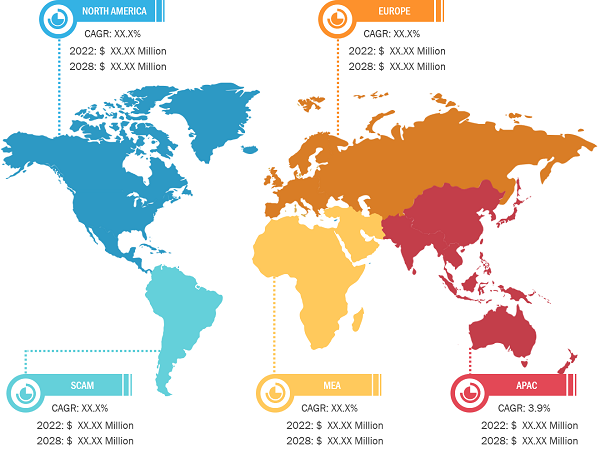Antibacterial Drugs, by Drug Class, to Dominate Hospital Acquired Infection Treatment Market During 2022–2030
According to our new research study on "Hospital Acquired Infection Treatment Market Size and Forecast (2020–2030), Global and Regional Share, Trend, and Growth Opportunity Analysis," the market is expected to grow from US$ 15,099.19 million in 2022 to US$ 19,978.39 million by 2030; it is anticipated to record a CAGR of 3.6% from 2022 to 2030. Key factors driving the hospital acquired infection treatment market growth are growing prevalence of chronic diseases, increasing geriatric population, and rising demand for minimally invasive procedures. However, the strong position of alternative treatment methods and therapies hinders market growth.
Central line-associated bloodstream infections, catheter-associated urinary tract infections, and ventilator-associated pneumonia are a few examples of healthcare-associated infections (HAIs). These infections, known as surgical site infections, can also arise at surgical sites. According to the January 2022 report from the National Healthcare Safety Network (NHSN), urinary tract infections (UTIs) are the fifth most common type of healthcare-associated infection. UTIs account for more than 9.5% of acute care hospital conditions.
Hospital Acquired Infection Treatment Market, by Geography, 2022 (%)
Hospital Acquired Infection Treatment Market Size and Forecasts (2020 - 2030), Global and Regional Share, Trends, and Growth Opportunity Analysis Report Coverage: By Drug Class (Antibacterial Drugs, Antiviral Drugs, Antifungal Drugs, and Others), Infection Type (Urinary Tract Infections, Ventilator-Associated Pneumonia, Surgical Site Infections, Bloodstream Infections, and Other Hospital Infections), Distribution Channel (Hospital Pharmacies, Retail Pharmacies, E-Commerce, and Others), and Geography (North America, Europe, Asia Pacific, South & Central America, and Middle East & Africa)
Hospital Acquired Infection Treatment Market Growth by 2030
Download Free Sample
Source: The Insight Partners Analysis
Catheter-Associated Urinary Tract Infection (CAUTI) is caused by urinary catheters used to drain urine from the bladder. CAUTI is one of the most frequent infections among hospitalized UTIs patients. According to the Centers for Disease Control and Prevention (CDC), nearly 75% of infections are related to a urinary catheter. During their hospital stays, 15% to 25% of hospitalized patients need to use urinary catheters. Prolonged urinary catheter use is the most major risk factor for getting CAUTI. CAUTI complications entail patient suffering, prolonged hospital stays, increased treatment costs, and even death. Furthermore, according to the CDC, UTIs are responsible for more than 13,000 deaths each year. Acute uncomplicated cystitis causes around six days of discomfort, resulting in ∼7 million office visits every year at a cost of US$ 1.6 billion. As a result, rising number of HAI cases places a significant financial burden on the healthcare system. The increasing prevalence of CAUTI, combined with the increased demand for drugs for treatment, is propelling the market.
The heightened emphasis on patient safety within healthcare facilities drives the necessity for robust infection treatment strategies, infection surveillance systems, and antimicrobial stewardship programs aimed at minimizing the impact of HAIs. Ongoing investments in healthcare infrastructure, including the establishment of state-of-the-art hospitals and expansion of medical facilities, necessitate advanced infection control and treatment measures to uphold patient safety and minimize HAI risk.
Stringent regulations, guidelines, and quality standards imposed by healthcare regulatory authorities worldwide drive the adoption of standardized infection control measures, antibiotic stewardship programs, and evidence-based treatment protocols to mitigate the burden of HAIs.
Merck & Co Inc, Pfizer Inc, AbbVie Inc, Paratek Pharmaceuticals Inc, Eugia US LLC, Abbott Laboratories, Cumberland Pharmaceuticals Inc, Innoviva Specialty Therapeutics Inc, Cipla Ltd, and Eli Lilly and Company are among the key companies operating in the hospital acquired infection treatment market. The companies have been implementing various strategies that contributed to their growth and led to various changes in the market. The companies utilize organic strategies such as launches, expansion, and product approvals and inorganic strategies such as product launches, collaborations, and partnerships.
In May 2023, Innoviva Specialty Therapeutics announced that the US Food and Drug Administration (FDA) had approved XACDURO (sulbactam for injection; durlobactam for injection), co-packaged for intravenous use in patients aged 18 years and above for the treatment of hospital-acquired bacterial pneumonia and ventilator-associated bacterial pneumonia (HABP/VABP) caused by susceptible isolates of Acinetobacter baumannii-calcoaceticus complex (Acinetobacter). Innoviva Specialty Therapeutics stated that it is focused on delivering innovative therapies in critical care and infectious diseases.
Similarly, in September 2020, Shionogi & Co Ltd announced that the FDA had approved a supplemental New Drug Application (sNDA) for FETROJA (cefiderocol) for the treatment of patients aged 18 years and above with hospital-acquired bacterial pneumonia and ventilator-associated bacterial pneumonia (HABP/VABP) caused by susceptible Gram-negative microorganisms such as Enterobacter cloacae complex, Klebsiella pneumoniae, Acinetobacter baumannii complex, Escherichia coli, Pseudomonas aeruginosa, and Serratia marcescens.
The report segments the hospital acquired infection treatment market as follows:
The hospital acquired infection treatment market, by drug class, is segmented into antibacterial drugs, antiviral drugs, antifungal drugs, and others. The antibacterial drugs segment held the largest market share in 2022 and is anticipated to register the highest CAGR during 2022–2030.
The hospital acquired infection treatment market, by infection type, is segmented into urinary tract infections, ventilator-associated pneumonia, surgical site infections, bloodstream infections, and other hospital infections. The urinary tract infections segment held the largest market share in 2022. However, the ventilator-associated pneumonia segment is anticipated to register the highest CAGR from 2022 to 2030.
The hospital acquired infection treatment market, by distribution channel, is segmented into hospital pharmacies, retail pharmacies, e-commerce, and others. In 2022, the hospital pharmacies segment held the largest market share, and the same segment is anticipated to register the highest CAGR during 2022–2030.
The hospital acquired infection treatment market, based on geography, is segmented into North America (the US, Canada, and Mexico), Europe (Germany, France, Italy, the UK, Russia, and the Rest of Europe), Asia Pacific (Australia, China, Japan, India, South Korea, and the Rest of Asia Pacific), the Middle East & Africa (South Africa, Saudi Arabia, the UAE, and the Rest of Middle East & Africa), and South & Central America (Brazil, Argentina, and the Rest of South & Central America).
Contact Us
Phone: +1-646-491-9876
Email Id: sales@theinsightpartners.com